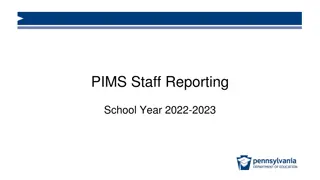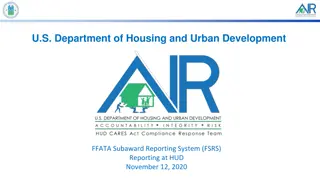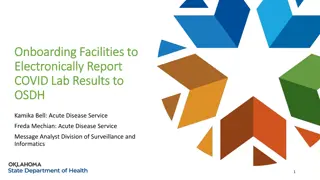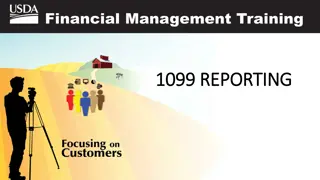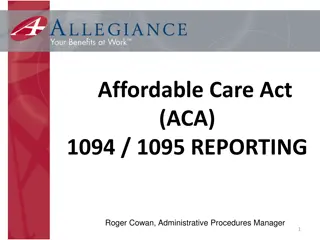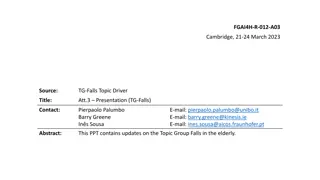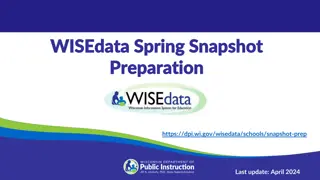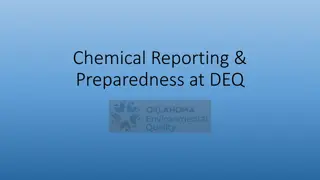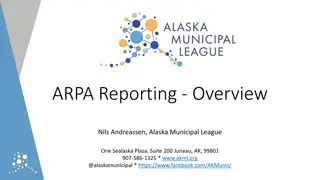Overview of Fall 2019 Reporting Information Session
High-level overview of TRS reporting for Fall 2019 including legislative changes, summary of rate changes for fiscal years, tips on starting a new year, and additional reporting tips. The presentation emphasizes the importance of accurate reporting and compliance with TRS Laws and Rules. Ensure timely submission of required reports and adherence to guidelines for reporting salary information, contributions, and demographic updates.
Download Presentation

Please find below an Image/Link to download the presentation.
The content on the website is provided AS IS for your information and personal use only. It may not be sold, licensed, or shared on other websites without obtaining consent from the author.If you encounter any issues during the download, it is possible that the publisher has removed the file from their server.
You are allowed to download the files provided on this website for personal or commercial use, subject to the condition that they are used lawfully. All files are the property of their respective owners.
The content on the website is provided AS IS for your information and personal use only. It may not be sold, licensed, or shared on other websites without obtaining consent from the author.
E N D
Presentation Transcript
Disclosure This presentation is intended as a high level overview of TRS reporting. This presentation should not be viewed as a comprehensive overview of the TRS reporting process. The information in this presentation is based on the TRS Laws and Rules as of the 2019-2020 fiscal year Please see the various RE Portal training and resources available on the TRS website for more complete information. 2
Legislative Changes Contribution rate increases (next slide). As of 9/1/19, ISDs will no longer use a Cost of Education Index (CEI) to adjust the state minimum salary. Public Education Employer Contribution due on all eligible members. Charter schools are required to pay the state contribution on eligible salaries paid above the state minimum set by TEA. 3
Summary of All Rate Changes Fiscal Year For pay received on or after Member Contribution rate State contribution rate Pension Surcharge Rate Public Education Employer (Non- OASDI) rate FY 20 9/1/2019 7.7% 7.5% 15.20% 1.5% FY 21 9/1/2020 7.7% 7.5% 15.20% 1.6% FY 22 9/1/2021 8.0% 7.75% 15.75% 1.7% FY 23 9/1/2022 8.0% 8.0% 16.00% 1.8% FY 24 9/1/2023 8.25% 8.25% 16.50% 1.9% FY 25 9/1/2024 8.25% 8.25% 16.50% 2.0% 4
Tips on Starting a New Year Ensure all ED40s sent by the September report period-one for each actual separate position the employee is working. Report time worked in first month of contract, even if employee is not paid until the next month. Do not report stipends under a separate position code unless it is truly a separate job. Submit any demographic updates prior to submitting September RP report 5
Additional Tips on Starting a New Year Use View Employee Information screen on all new hires, even if they previously worked for your RE. Make sure contact list is current. There must be a Web Administrator, Head of Institution, Reporting Official, and Payroll Contact designated. Review ledger balances. 6
Other Reporting Tips When completing Refund Certification in RE Portal, use month and year for final report month. (MM/YYYY) On adjustment records (RP25, ER27) only adjust the difference between what was originally reported and the correct amount. ED90s must be sent in for anyone who terminates all employment for any reason. Not to be submitted if employee only changes positions. Flag for Non-Standard Work Week on ED40-please use Yes if the person is scheduled to work fewer than 5 days a week. 7
Temporary vs. Part Time Employment Temporary employment is total employment lasting less than 4 months Irregular or seasonal employment that will cover more than 4 months of the school year must be listed as Less Than Half Time 8
Dual Credit RE where work is performed reports days and hours worked RE who pays the person reports the compensation 9
Substitute Active employee working in a vacancy is NOT a substitute TRS Audit is monitoring retired substitutes in vacancies Recommend REs establish a way to document the employee of record who a person is subbing for 10
EAR Reporting Must track time for all retirees because must report actual time no exceptions Employment dates must be between 9/1-8/31, do not have to be 9/1- 8/31 Employment dates can be reported month to month 11
Concurrent Employment If an employee does not meet eligibility solely at your RE, but the View Employee Screen says they are a TRS member, please reach out to the employee and request that they provide answers to the following questions: 1. Are you currently contributing to TRS at another employer? 2. What are the start and end dates of your work agreement at that other employer? 3. How many hours are you scheduled to work per week at the other employer? 12
Non-higher education personnel Reporting coach will be outside to answer questions 13
Higher ED-ORP Notify employee of ORP eligibility in timely manner Send in the TRS28 as soon as it is complete Use only the current version of the TRS28 available on the TRS website Submitting ED40s accurately is critical. 14
Reporting ED 40s for ORP Participants SCENARIO 1 The employee is already enrolled and participating in ORP prior to the beginning of the fiscal year. Action Submit the ED40 record with TRS Membership Eligibility flag of No and an ORP Eligible Position flag of Yes. The Beginning Date of Contract/Work Agreement and Ending Date of Contract/Work Agreement fields should reflect the dates the employee was hired to work in that fiscal year. 15
Reporting ED 40s for ORP Participants Scenario 2 The employee is hired into a TRS-eligible position during the fiscal year that is also an ORP-eligible position. Action 1 Submit the initial ED40 record with TRS Membership Eligibility flag of Yes and ORP Eligible Position flag of Yes. The Beginning Date of Contract/Work Agreement and Ending Date of Contract/Work Agreement fields should reflect the dates the employee was hired to work in that fiscal year. Please note: If the member later decides to elect ORP during the initial election period, but has contributed to TRS for the months prior to the ORP election, then an additional action will need to be completed. 16
Reporting ED 40s for ORP Participants Scenario 2 Continued Action 2 Submit an ED45 adjustment record to both end the TRS-eligible positon and to add the ineligible position using an Adjustment Reason Code of End/Add. Ensure all of the original fields match the information that was submitted on the initial ED40 record. Then, complete all of the new fields with the ORP contract information. Be sure to indicate the New TRS Membership Eligibility flag as No and the New ORP Eligible Position flag as Yes. The New Beginning Date of Contract/Work Agreement field is the date the employee s ORP participation began (the effective date of the ORP election). Must submit a completed TRS 28 election form to TRS by the end of the ORP election period. 17
Reporting ED 40s for ORP Participants Scenario 3 The employee is hired into a TRS-eligible position during the fiscal year that is also an ORP-eligible position; however, the employee decides to remain in TRS and does not elect ORP. Action Submit the initial ED40 record with TRS Membership Eligibility flag of Yes and an ORP Eligible Position flag of Yes. The Beginning Date of Contract/Work Agreement and Ending Date of Contract/Work Agreement fields should reflect the dates the employee was hired to work in that fiscal year. No ED45 adjustment record is needed since the employee did not elect to participate in ORP. 18
Higher Education Personnel Reporting coach will be outside to answer questions 19
Changes to Non-OASDI Social Security contributing employers are no longer except from the 1.5% public education employer contribution. The purpose of the public education employer contribution is to remit on a monthly basis a percentage of the total amount of eligible salary paid to members. Charter schools will not have the Public Education Employer Contribution capped at the State Minimum Salary. The report will no longer be named Reporting Entity Payment for Non- OASDI Members (NO). The report will be renamed Public Education Employer Contribution (EC). 20
Statutory Minimum HB3 requires Open Enrollment Charters to pay the state s contribution on salary amounts in excess of the state minimum salary schedule published by TEA. This applies to Charter School employees who would be entitled to a minimum salary if they were employed by a school district subject to Section 21.402, Education Code. 21
Positions Subject to Stat Min under 16.056 PER SECTION 16.056 OF THE TEXAS EDUCATION CODE, THE FOLLOWING POSITIONS WERE ENTITLED TO THE MINIMUM MONTHLY SALARY AS THIS SECTION EXISTED ON JANUARY 1, 1995. Superintendent Educational Diagnostician Instructional/Admin. Officer Key specialist or director of a major instructional program or group Administrative Officer Assistant to superintendent or high grade administrative officer, works in administrative capacity in personnel, business, accounting, planning, research, etc. Principal (part-time, full time or assistant) School Social Worker Physical Therapist Occupational Therapist Physician, M.D. Psychological Associate Bachelor s/Master s Degree Special Education Related Service Personnel Bachelor s/Master s Degree Psychologist Entity s responsibility to classify and apply consistently based on the position, not person.
Compensation Subject to Statutory Min. Compensation paid for services performed: As a teacher, full-time librarian, counselor, or nurse; OR In a position covered under former Section 16.056* of the Texas Education Code (i.e., superintendent, principal, administrative officer, instructional officer, diagnostician, etc.); PLUS Any supplemental pay for duties that are part of a particular position that is subject to the state minimum salary. Examples include, but are not limited to: stipends for sponsorship, UIL activities, coaching duties, tutorial assignments. Additional work that is not part of a particular position that is subject to statutory minimum is called wholly separate and will be discussed later. 23
State Minimum Salary Schedules TEA published a new Statutory Minimum for 2019-2020 The new salary schedule is effective when the employee begins their new contract for 2019-2020 Table 1 State Minimum Salary Schedule applies to members employed as teachers, full-time librarians, full-time counselors or full- time nurses. Table 2 and Table 3 State Minimum Salary Schedule applies to positions subject to Stat Min under section 16.056 in January 1, 1995 24
State Minimum Salary Schedules Cont The years of Experience that an employee has is used determine their State Minimum Salary step To determine the monthly State Minimum salary, use: Number of days in the contract Number of months the annual compensation will be paid out (10, 11 or 12 months) 25
Calculation of Statutory Minimum The calculation to attain the salary paid above the state minimum salary will be the Eligible TRS Gross Compensation paid in the report period less the State Minimum Salary for that member. On the RP 20 record, report the monthly State Minimum amount from the salary schedule table in the Adjusted State Minimum Compensation field. Statutory Minimum contribution is not due if the employee is paid an amount equal to or less than the Statutory Minimum Compensation 26
Wholly Separate - Not Subject to Stat Min. If an employee takes on another job that is unrelated to their primary position, that job is considered wholly separate . Compensation earned under the wholly separate position is not subject to the above state minimum contribution. 27
Wholly Separate - Continued To determine if a job is Wholly Separate, answer the questions below. If the answer to any one of the following questions is Yes , then it is probable that the additional duties are part of the duties of the particular job subject to the State Minimum Salary Schedule and do not constitute a wholly separate job. Therefore, include the salary paid for the additional duties in adjusted TRS salary. 28
Please reach out to your coach or reporting@trs.texas.gov if you have any questions or need assistance. 29





